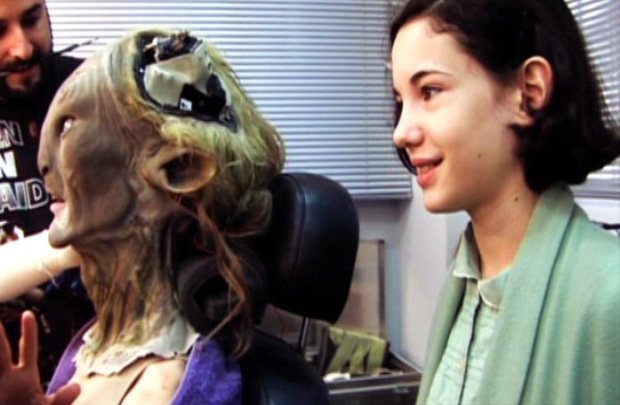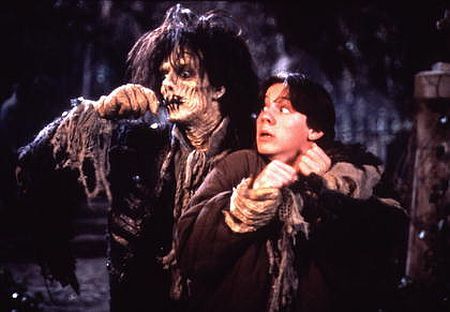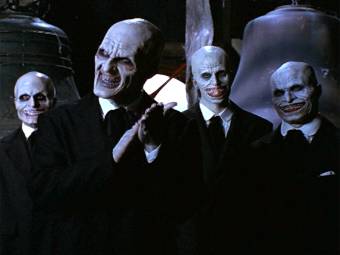
Doug Jones became known for his roles where his face was usually completely hidden underneath a ton of makeup. But his talent rose through all of that latex and rubber, creating some incredible characters over the years. We had a chance to talk to him at the HorrorHound Weekend show back in Aug. of 2008, in Jones’ hometown of Indianapolis, Indiana. Out of all the celebs that I’ve met over the years, Jones is one of a kind, and one that you’ll never forget once you meet him.

Kitley’s Krypt: Even though you’ve done plenty of movies without extensive makeup, you’ve seen to become more predominate now that you’ve done roles with your face hidden behind all that makeup. How do you feel about that?
Doug Jones: I feel good about it, actually. If you would have asked me that a few years ago, I would have told you that I’d be looking forward to the end of my career being without makeup at all, so I could age gracefully without having to wear rubber on my face.
However, I got perked up again. I got revived and more energy for the roles in prosthetic make-ups, because of the dignity and the respect that’s coming back to those kind of roles. For so long you were stuck in a creature category, and thought of the “guy in suit”. Where as in the movies like Pan’s Labyrinth and the Hellboy franchise, and Silver Surfer, it’s brought an attention and a dignity to that style of acting again, much like Boris Karloff and Lon Chaney had. So with that, I could retire with rubber on my face. I would be happy to take it that far now.

KK: Since your face is covered in these make-up creations, what do you do as an actor to breathe life into those characters?
DJ: Acting is acting. So whether I’m wearing a light dusting of powder that day on a sitcom, or wearing heavy rubber prosthetic make-ups, I still have to find the heart and soul of the character. That’s really where it starts with me. The main purpose for me as an actor is to get into the character with the script and find out where he fits into the story and all that. My next step is to go to a dance studio with mirrors and a wood floor and just myself. Then figure out, from the script and talking to the director, how does this character move, walk, talk, lunge for things, run, squat, all those things that’s called upon for him to do, and how do I work that out visually. I try to open up myself and let the character come in and play him through me physically.

Then the make-up process starts with all the make-up tests and costume fittings and all that. Then you learn a lot more about the character from that. A transformation does happen to you physically. I want to get that all out of the way, so by the time I’m on the set with the camera rolling, with the lights up, and the other actors on set with me, and they yell “Action”, I want it to be an organic thing that is happening as though that character woke up that way that day and is not a guy in a suit. So that all I need to concentrate on is when they yell “action” is what’s my intention in the scene, what’s the relationships in the scene, where’s the scene going, what are my wants, needs, desires, all those things. That way I don’t have to worry about where does my elbow go and how heavy the suit is. That’s all been worked out ahead of time.
KK: So the development of the character starts before the make-up tests, or how does that change once you find out what limitations you might have in the make-up?

DJ: I can work out as much as I want in front of a mirror with myself and a pair of shorts. But once the make-up and costume get applied, and all the tests, when I go into for fitting after fitting, there’s some limitations now. Maybe the head doesn’t turn as far to the left as I’d hoped. Or maybe the arms don’t lift as high over my shoulders as I’d hope. But that’s where the creature lives now, in these little movements. Or maybe sometimes there’s an enhancement, like finger extensions or horns on the head that make the tilt on the head more accentuated. So I have more capabilities then some as well. Or there’s leg extensions or you’re up on stilts. You find that out when you go through all of your fittings.
KK: What was the longest you had to sit in the make-up chair?
DJ: The longest was 7 hours on the first Hellboy. Abe Sapien took 7 hours with 3 make-up artists putting him together. When you saw me with just shorts on, that’s a lot of blue fish-guy showing. The more costuming I wear, you know the longer the sleeve, or the longer the pants, if there’s black gloves on that day, it takes less time for make-up for that’s all costuming. It just slips on.

For the second Hellboy, they streamlined it down to 5 hours. By using fewer pieces, instead of having 12 prosthetics pieces, they had more like 8. They could like combine the arm and the chest piece together, where it would just slip on and glue down the edges. So the longest was 7 hours, and the shortest, in the prosthetic world, would be something like the Silver Surfer, which only took 2 hours. It was 2 simple pieces. The head and shoulders and chest were all one piece. And the rest of the body would slip up in a body suit and they would glue down the edge together. And then you’re ready to go. Depends on how simple or complicated, but its all part of the day I say “yes” when I say yes to the job.
KK: What do you normally do during that time?
DJ: I zone out a lot. I get to know my make-up artists really well. We joke around a lot, tell stories, listen to music, and watch things on YouTube if there’s a laptop in the trailer. And I do zone out and fall asleep sometimes too if my head is at an angle where I can do that.
KK: You first met Guillermo del Toro on Mimic. What was your first impression of him?
DJ: My first impression was he the director or a fan-boy? He’s really a fan-boy first, I came to find out. Because on Mimic, he sat with me at lunch time on my second day and asked me all these questions like “What other creatures have you played?” and “What make-up artists have you worked with?” And he had his chin in his hands, fascinated listening to all my stories. He told me that he had started as a make-up effects artist in Mexico. Monsters are a love of his. He asked me if I had a card. So I gave him this goofy card of mine and he stuck it in his wallet. Then 5 years later, when he was doing the design for Hellboy, when he approved the design for Abe Sapien make-up, he was congratulating the guys at Special Motions, the creature shop on a design well done. One of the designers said, “This looks like Doug Jones.” Guillermo said (with Doug doing a great impression of Guillermo) “Doug Jones? I know Doug Jones.” And he pulls my card out of his wallet. So they called me and that’s how Abe Sapien happened for me.

So my relationship with Guillermo goes on to this day. We’ve now done 4 films together. Of course there’s talk of more. He’s got The Hobbit coming up. He’s got other projects that he’s had in his cooker for a while that he wants to do. H.P. Lovecraft’s At the Mountains of Madness. He wants to do his own adaptation of Frankenstein. Those are all things that my name gets thrown into the pot quite a bit with him.
We have a great working relationship. He trusts me as an actor and I really trust him as a director. He’s one of those directors where he knows my potential more than I do. So when he says he wants me to do something, and I’m sure there’s no way in heck that I can pull it off. He’s sure I can, and I have to trust his instinct more than my own. That’s how Pan’s Labyrinth happened. I was sure I couldn’t do this. I was sure that I couldn’t walk on out stilts as a fawn, speaking Spanish. I was positive that I was going to ruin his movie. He was positive that I was the only one in the world that could play it. So thankfully, he knew more about me than I did. I’m very grateful to him. Directors like that are rare. And for me to fall into his very capable hands, I’m blessed.
KK: Has he changed since when you worked on Mimic to now?
DJ: His personality has not changed, and will never change. He is as delightful today as he was then. He will always be a little boy who is delightful and a big fan of movies, big fan of art, big fan of artists, and writers. The only thing that has changed is how other people perceive him. And that’s only getting better. He’s getting more and more respect with every movie he makes. And after being down the red carpet at the Oscars with 6 nominations with Pan’s Labyrinth, they better respect him, darn it!
But he’s still the same guy; he’s just a little more busy. He has an assistant now, and more gray hair sprouting because the stress in his life. But he’s still a young man with a long, long career ahead of him.
KK: How did the role of Cesare in the remake of The Cabinet of Dr. Caligari come about?

DJ: I loved doing Dr. Caligari. That was a process I’d never been through before. We shot the entire film on green screen, and they plopped us into the original film’s backdrops. I had never done anything like that before. And to reprise a beloved silent film iconic role like Ceasare, the somnambulist, was intimating for me. Because of Conrad Veidt, who played it the first time did such a brilliant job of it, I felt there’s gigantic shoes to fill. When you do a role like that, for me, it’s best not to watch the original performance so I can do my own thing with it. But I thought, no, this is such a stylized piece and it needs to really stay in that German expressionist style. We’re going to be plopped in the original film, so we really need to pay attention that original film. So I watched Conrad’s performance, and I absorbed as much as his take on Cesare as I could, and then I have a little Doug Jones in there because I have too. I come into the room as Doug Jones, so I have to kind of give you some of that. I’m really happy with what we pulled off there. I thought it was so innovative. I loved the original silent film. Seeing them back to back is the way I would advise anyone to see The Cabinet of Dr. Caligari. See the 1919 silent version. Then follow it right away with the 2007 talkie version, also in black and white. It’s so much fun to compare and contrast the two. Plus, they’re both short, so you can do both of them back to back. It’s a very short double feature. The second one, with the dialog, it helps fill in the gaps that silent always leaves. In silent films, you’re watching a lot of action, with people ranting and raving, and then a dialog card comes up that says “Yes, Mother”. And you’re like “Wait…they said more than that!” So our version of Caligari will give you more. It doesn’t give you more that’s daring and innovative, it gives you more that’s true to the original story.
KK: Are you a fan of the horror genre?

DJ:Not so much a fan of horror genre. Classics? Yes. Blood and guts? Not so much. Gratuitous gore is not my thing so much. But if gore is part of the story that going somewhere that has a redeeming quality to it, with characters that I care about, then yes, I love that. The kind of horror that I’ve been involved with, are stories I love watching. I loved my episode of Fear Itself. I loved the writing; I loved the relationships in that story. I love Larry Fessenden as a director.
I loved my episode of Buffy the Vampire Slayer. Josh Whedon is a genius. What he put together with the “Hush” episode was daring and innovative, with doing over half the episode in silence. The Buffy characters was already established and I loved being part of their world for an episode.

In movies like Pan’s Labyrinth, they are artful and hopeful and reflective of all the monsters that we have in our own childhoods. Here we’re watching this little girl going through hers, with an element of horror to it. There was some blood and guts in that movie. Yes. But the reality of that movie was the horrific part of it really. So that kind of stuff, absolutely. I love it. It’s a genre that’s been good to me. And the fans have been very, very good to me. So when coming to a place like HorrorHound Weekend here, it’s nice for me to come here and have access to the people who bought the stuff I’ve been in over the years. I love.

KK: Thank you for coming out. It’s always great for fans to have the chance to meet people face to face. And especially people like you, since we don’t normally see your face. So thank you.
DJ: Well thank you for looking at my face and thinking I’m not scary.
KK: Not at all! Thank you for taking the time and talking with us.
DJ: Absolutely. Thank you for having me.

Pingback: How Doug Jones Became Guillermo del Toro’s Favorite Monster vidkee – Read Kee